The candidate site for the ILC lies in the Kitakami highlands of Iwate Prefecture, northern Japan. The city of Hanamaki is located in its central region, and is easily accessible by the Iwate Hanamaki Airport, the Shin-Hanamaki bullet train station, and the Tohoku Expressway. It’s also blessed with nature, and is popular with tourists because of the Hanamaki Hot Springs area, one of the most well-known hot springs in the Tohoku region. Hanamaki is also known for being the birthplace of the author Miyazawa Kenji, famous for writing the novel “Night on the Galactic Railway.” All in all, it’s a wonderful place for tourists to visit.
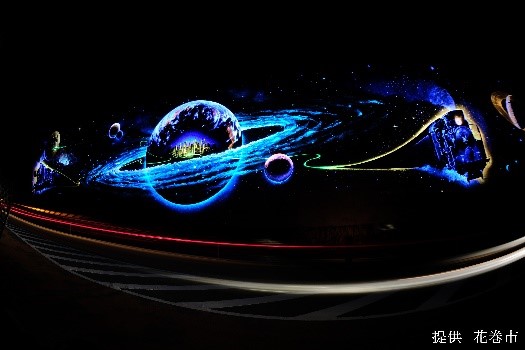
The Future City Galactic Railroad(Mural)
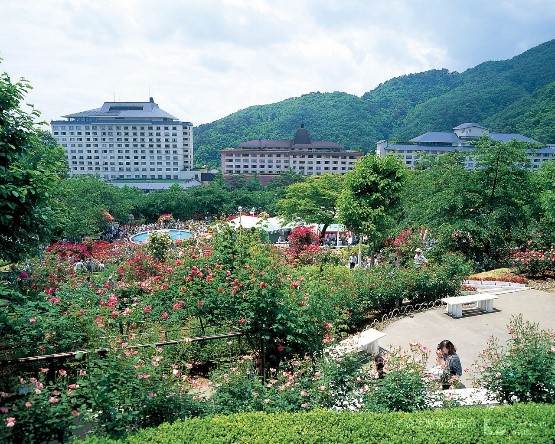
Hanamaki Hot Springs Area
A major attraction is in the Hanamaki Festival held in September every year. This festival boasts over four centuries of history and tradition, with 120 portable shrines hoisted throughout town, and traditional performances like the Shishi Odori dance – dancers wear masks representing deer and lions in order to ward off bad spirits. There’s so much to see, and the 120 portable shrines have even been recorded in the Guinness Book of World Records.
The Hanamaki Festival is said to have started in 1613 when the townspeople paraded about town in a show of respect for town founder and lord of Hanamaki Castle, Kita Shosai. The centerpiece of the festival are the large “dashi” floats that are said to be carriers for the gods.
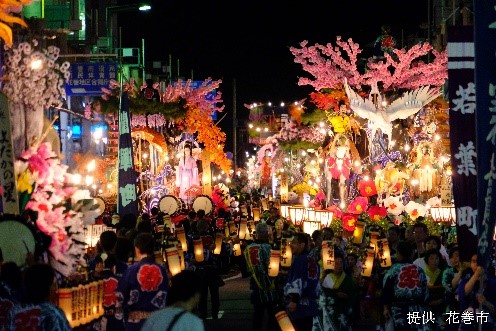
Hanamaki Festival(A Parade of Dashi Floats)
These dashi floats used throughout festivals and religious ceremonies in Japan, and are called dashi as that’s the word for pushing and pulling things around. These large carts are decorated in a number of different themes – samurai generals from the warring-states period of Japan’s history, figures from Japanese fairy tales and the like. These life-size dolls are filled with personality, and the colorful dashi are adorned with boulders, flowers, and other decorations.
Making the dashi is split up into different tasks, and some areas start making dashi as early as July. For example, the cherry blossoms and peonies that adorn the floats are made by dyeing and drying washi paper formed into petals. They’re coated with wax so they won’t rip when blown by the wind. This entire process is repeated over and over to make the dashi.
Hanamakians start getting involved with making the dashi in elementary school. People work under the dry, scorching sun to apply the wax coating, tiring from the heat of the wax – it’s very hard work. But these hard workers want to produce successful festivals, so air is energetic, and the workers are happy and fulfilled. These city residents love the festival, and fully use their skills that they’ve honed over many years. They work on the floats after their day jobs and on weekends, and are truly the epitome of professionalism. In a way, the real thrill of the Hanamaki Festival is the process of putting it all together.
On the day of the festival, the final decoration is the people of town coming together to see the floats. Small children beat their taiko drums in time with the flutes, drums, and sounds of the Hanamaki Festival, guiding the dashi forward. They were golden crowns on their heads, and white makeup on their adorable faces, with the light of the dashi shining on their faces. The Hanamaki Festival is the final stage for the performance they’ve been practicing so hard for.
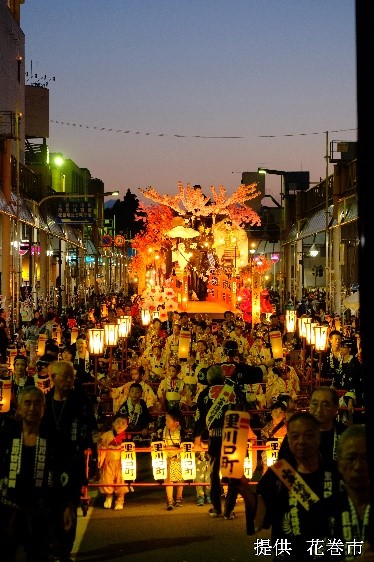
Hanamaki Festival(Children Parading Down the Street)
During the night of the parade, the dashi marching through the commercial district are lit not with electric light bulbs, but with gas lamps. The flames, flickering in the wind, make the dashi look more beautiful and mysterious, stealing the hearts of all the festival-goers. The commercial district will be full of food stalls, where you can eat delicious food, drink beer, and watch the parade. It truly is the best time of the year!
For the past two years, the parade was cancelled due to the COVID-19 pandemic, but it was able to overcome that to be held in September 2022 for the first time in three years.
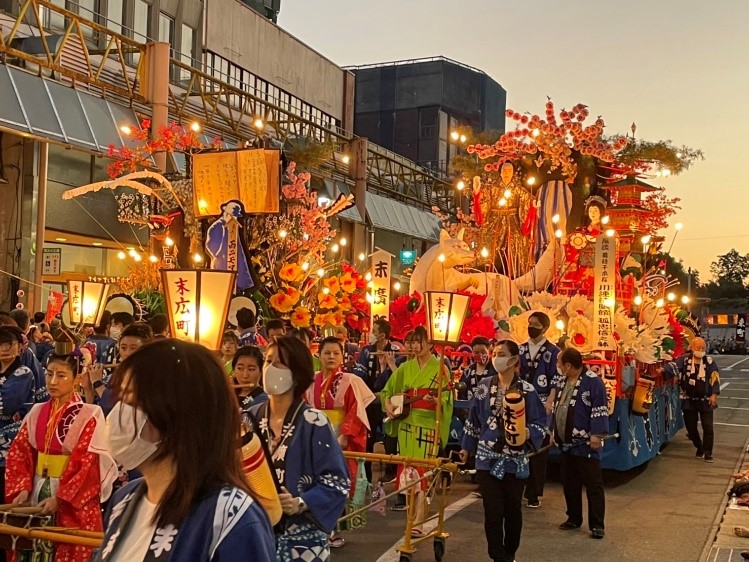
Hanamaki Festival(First Time in Three Years)
It was a smaller parade this year, but it still brought joy to the hearts of the people of Hanamaki, who have been waiting so long. Festivals are not just things you go to see, they’re things that you can enjoy as participants, making the dashi or carrying the portable shrines. We hope you one day get to participate yourself!
Japanese
400年以上の歴史と伝統 幻想的な世界が広がる「花巻まつり」ILCの建設候補地、北上山地が広がる岩手県。その中西部に位置する花巻市は、いわて花巻空港や東北新幹線新花巻駅、東北自動車道などの交通網が整備され、自然豊かで、東北有数の温泉地「花巻温泉郷」を有する観光客に人気のまちです。また、「銀河鉄道の夜」で有名な、宮沢賢治の生誕の地としても知られ、観光客への見どころがたくさんあります。
【写真】【写真】
中でも、毎年9月に行われる花巻まつりは、400年以上の歴史と伝統を誇り、120基近くが繰り出す神輿や、悪霊退散を祈願して鹿や獅子をかたどった頭をかぶって踊る獅子踊りなど、見どころがたくさんあります。120基の神輿はギネスにも認定されています。
花巻まつりは、1613年、町人たちが、花巻開町の恩人である花巻城主北松斎を敬愛して、町内を練り歩いたことが歴史の始まりと言われており、巨大な神様の乗り物とも呼ばれる山車が、まつりの花形です。
【写真】
山車とは、日本で祭礼の際に、引いたり担いだりする出し物の総称で、巨大な台車のようなものです。山車は、戦国武将やおとぎ話の登場人物など、多様なテーマをモチーフにした、個性豊かな人形と、岩や花など様々な飾りつけが、色とりどりに施されます。
山車づくりの作業は、分業制で、早い所では7月頃から始まります。例えば、人形の周りを彩る桜や牡丹は、和紙でできた花びらを染めて、乾かして、雨風にさらされても壊れないようにロウ塗り作業を繰り返し行い、作られます。
山車づくりは小学生のころから携わります。ロウ塗りは、炎天下の日照り、ロウの熱さに体力を奪われる大変な作業。しかし、作業場は祭りを成功させるため、活気にあふれていて、作業に携わる人たちは、楽しさや充実感も味わえます。祭りを愛する市民が、長年磨かれた技術を存分に発揮し、仕事終わりの夜や休日に汗を流しながら山車を創り上げる様子は「プロフェッショナル」そのもの。山車が出来上がるまでの過程も、まつりの醍醐味です。
まつり当日に、山車をより輝かせるのが地元の人々で、花巻囃子と呼ばれる優雅な大太鼓や笛の音に合わせて、稚児が小太鼓を叩きながら山車を先導します。頭に金色の冠をかぶり、おしろいできれいにお化粧した稚児たちが、山車の灯りに照らされる姿はとても可愛らしいです。まつりは、子どもたちが練習の成果をお披露目する最高の晴れ舞台でもあります。
【写真】
夜のパレードでは、山車は、電球ではなく、アセチレンガスの炎を照明に使った山車が商店街の大通りを練り歩きます。風に揺られる炎が、山車をより美しく、幻想的な姿に変貌させ、見る人の心を奪います。商店街には屋台が並び、おいしいものを食べながら、ビールを飲んで、パレードが見られます。そんな時間は本当に最高です!
この2年間、新型コロナウイルスの影響で中止を余儀なくされた花巻まつり。困難を乗り越え、今年の9月に、3年ぶりにまつりが開催されました。
【写真】
規模は縮小されましたが、まつりを待ちわびた多くの市民の心に光を灯しました。まつりは、見物だけではなく、山車や御輿の運行など参加者として楽しむこともできます。ぜひ遊びに来てみてください!



